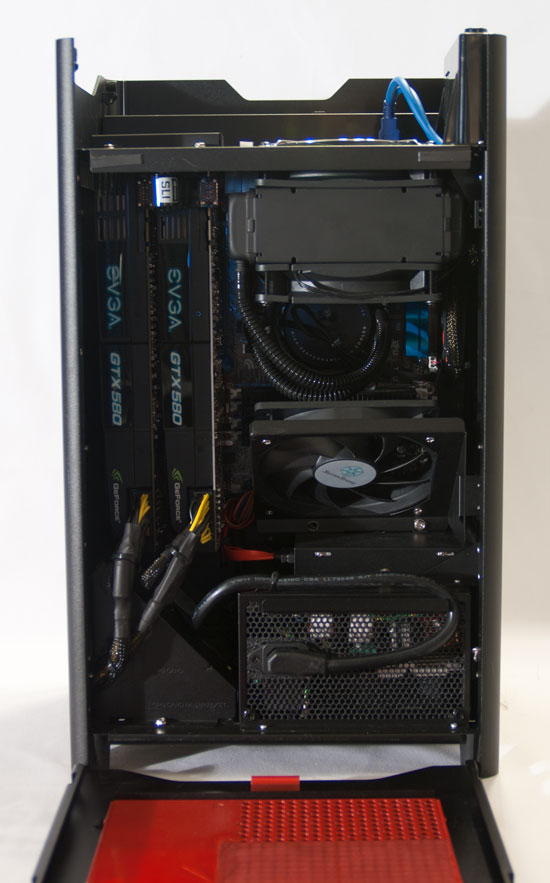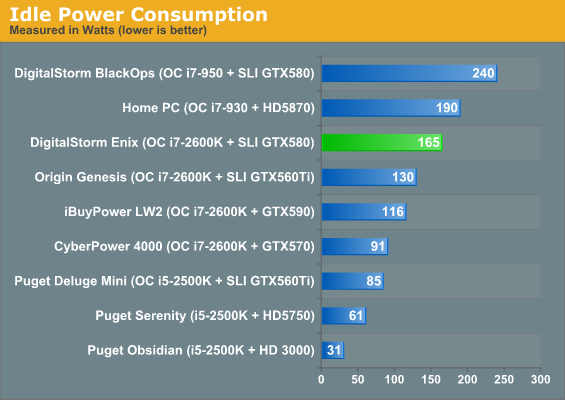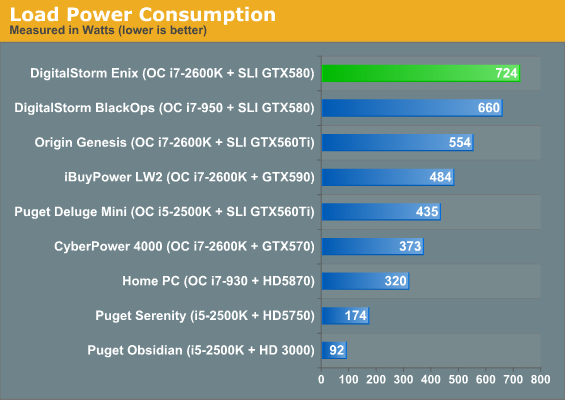DigitalStorm Enix: Phenomenal Cosmic Power, Itty Bitty Living Space
by Dustin Sklavos on May 12, 2011 12:00 AM EST- Posted in
- Systems
- Intel
- Sandy Bridge
- SilverStone
- DigitalStorm
Build, Noise, Heat, and Power Consumption
Given the SilverStone FT03's essentially compact frame but excellent thermal qualities (particularly for blower-style graphics hardware), it would be easy to pin a lot of the DigitalStorm Enix's success on SilverStone's engineering. But as we've seen with the different boutiques, which chassis to use for which build is still a choice specific to that boutique, and DigitalStorm's choice to use SilverStone Fortress series enclosures for both of their review units speaks highly of them. This is an important decision and we're pleased to see no corners were cut.
That said, our experience with SilverStone's enclosures is that their stock configurations seem almost designed expressly for fine-tuning by the end user. While the red trim added to the plastic grilles of the FT03 is a nice touch, it doesn't take away from the fact that DigitalStorm could've done a bit more with this enclosure. They offer fine-tuning and even replacement of the fans in the FT03, and that would've been appreciated in our review unit as the stock fans in the FT03 can be a bit noisy--effective, yes, but still noisy. This case can do better and should in the hands of a custom builder.

As you can see, the inside of the FT03 is pretty packed due in no small part to the massive pair of graphics cards and the equally substantial Corsair H70 water-cooling rig. The H70 proves to be remarkably effective at dissipating heat in this enclosure, but I found something troubling when I monitored heat and voltage. Check out these thermals:

The high temperatures on the GTX 580s are still well within spec for those cards, but look at the core temperatures on the i7-2600K and then take a look at the Vcore. We've noticed in testing that when the system boots up, there's a large spike in the Vcore up to 1.52-1.54V, which is disturbingly high. This spike does level off after about a minute, and in stress testing with Prime95 the voltage peaks at a less troubling 1.48V.
Of course, that's still incredibly high for a 32nm processor, and high enough to give me pause about the processor's continued stability and lifespan at this overclock and voltage. DigitalStorm's engineers did say this was about right for how they ship the processor and their warranty will cover it if it goes south, but that doesn't change the fact that this voltage seems far too high.
I had a reader email me and suggest that if I'm going to cite lazy overclocks in boutique systems, I should try overclocking the chips myself. I agree by half: I'm not going to try to push the chips any harder (especially since these vendors do make some money in charging for higher overclocks), but I can definitely see if I can get the voltage to run lower. A quick and dirty visit into the ASUS board's UEFI showed a +0.21V offset on the processor; I was able to reduce this to +0.06V and still achieve stability in a quick five-iteration Standard run of IntelBurnTest. This isn't a rock solid stability test, but I was able to increment down far enough that conceivably within the 0.15V range I tested in there's a 24/7 stable setting. I'm still certain I probably could've gone lower on the offset, but my point is essentially made: this could've been tuned a lot better. Just my reduction in voltage brought load temperatures down 10C on the processor cores.


And the high voltage on the i7-2600K takes its pound of flesh. At stock speeds the i7 and pair of GTX 580s have a combined TDP of 583 watts. When load tested in Mafia II (which hammers both the processor and graphics subsystems surprisingly hard), the Enix consumes a staggering 724 watts. Raising the Vcore as much as DigitalStorm did can dramatically increase power consumption, and that seems to be exactly what's happening here. Even the i7-950 in their BlackOps wasn't overvolted this far (though it also isn't nearly this fast).
















32 Comments
View All Comments
randinspace - Thursday, May 12, 2011 - link
I think his point was that they'll just give you what they value it at when it dies, which a lot of companies do in other industries now that products and parts don't stay on the market indefinitely.Although even if they decided on a flat $300 or so they should be covered by inflation, the profit they made off the rest of the unit as a whole, insurance, tax write-offs, etc.
fingerbob69 - Friday, May 13, 2011 - link
I don't know if US law is different to UK law in this regard but if the cpu was to die during the 10 yr guarantee period, in say year 9, then DigitalStorm would be obliged to replace it with an equivalent chip ...or better.As the customer, I would interpret that to be Intel's latest/last mid range release. So for example, if I had had a duff i7-750 in a DigitalStorm unit, with that chip having gone eol some years past, I would today be expecting a 2600k as replacement...which of course means a mobo change also as the two are integral to each other.
Belard - Saturday, May 14, 2011 - link
If you go back 5 years ago... the TOP Dog CPU was the Intel Core 2 Extreme X6800, which was about $500 USD.Today, a $60 AMD X2 bottom end CPU is just as fast and its a 1 year old CPU. So it takes about 3~4 years for a $500~900 CPU to be replaced by a $100 or less bottom end model.
Is there a typo, don't recall an i7-750. An i5-750, yes.
Common sense, they'd have to replace the board and maybe the memory too if an O/C CPU dies. I'm sure they'll be updating the BIOS with better controls ASAP still. If in 5 years, they need to replace the CPU, as long as its faster - even at $60, it'll be fair. With 16GB costing about $200 today, it should be about $20 in 10 years :)
LOL... you'll be OLD and saying "I remember the says when we had 2 core CPUs! Imagine that! Can't imagine how I got anything down with 3Ghz Quads"
Would warranty of the CPU cover the labor to replace it and the system board?
qwertymac93 - Thursday, May 12, 2011 - link
Hmm, dual 590s? trade those for dual 6950's and upgrade the SSD to a 240GB vertex 3, then we are talkin'.qwertymac93 - Thursday, May 12, 2011 - link
Meant 580, Not 590. Man, not having an edit feature sucks...MeSh1 - Thursday, May 12, 2011 - link
No peek inside?arthur449 - Thursday, May 12, 2011 - link
In Silverstone's FT03 manual, they strongly recommend removing the angled 120mm fan shroud under the video cards and mounting a pair of 80mm fans in its place when using two cards in Crossfire/SLI.Azfar - Thursday, May 12, 2011 - link
Err..i'm a bit confused looking at the optical drive bay. the conventional drive won't work at this slot type....right ?JarredWalton - Thursday, May 12, 2011 - link
Correct; you need a slot-loading slim laptop drive, which adds to the overall cost.Zap - Thursday, May 12, 2011 - link
It isn't too bad a cost for a combo drive. Try pricing out (or even finding these days) a slim slot load BD burner! Back when the Panasonic one was available, they were running close to $600 for just the bare drive!I did a quick price search and the Optiarc used in this DigitalStorm rig runs about $150. Expensive? Yes, however not exorbitantly so.